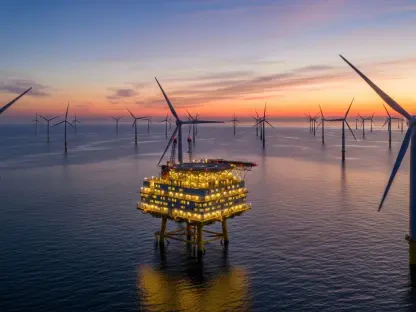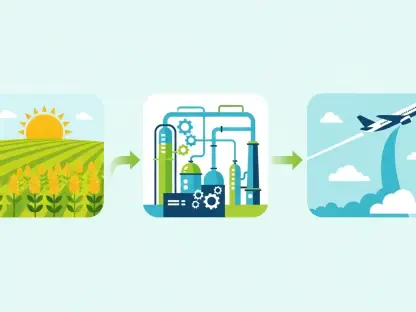Christopher Hailstone has extensive experience with energy management, renewable energy, and electricity delivery, making him a leading expert on grid reliability and security. His unique insights help illuminate the complex landscape of utilities and sustainable investment. Today, he discusses the evolving dynamics of ESG investments, particularly regarding oil and gas companies.
What factors led ESG investors to reconsider their stance on defense stocks after Russia’s invasion of Ukraine?
The unexpected geopolitical tension caused by Russia’s invasion of Ukraine prompted many ESG investors to re-evaluate the role of defense companies. In times of conflict, defense stocks can align with the broader goals of maintaining national security and stabilizing global markets. This shift underscores the importance of context in ESG considerations, where the immediate need for security temporarily outweighs traditional exclusions.
Why do you believe it’s time for ESG investors to re-evaluate their approach to oil and gas companies?
It’s essential to reassess this stance because we often overlook the significance of oil and gas companies in driving the energy transition. While these firms traditionally focus on fossil fuels, many are becoming major investors in low-carbon technologies. Excluding them entirely could hinder progress toward sustainable energy goals, especially considering their financial capabilities and expertise in the energy sector.
How have European energy majors’ investment strategies recently changed, particularly in terms of renewable spending and fossil fuels?
European energy majors have shifted towards pragmatism in their strategies. Faced with economic pressures, they have slashed renewable energy investments to enhance shareholder returns through fossil fuel projects. This scenario reflects a broader trend of balancing immediate financial imperatives with long-term sustainability goals. Companies are doubling down on fossil fuel production to ensure energy security and affordability, especially in volatile market conditions.
Can you explain what ESG-focused investments typically prioritize and which companies they commonly exclude?
ESG investments prioritize companies demonstrating leadership in addressing climate change, upholding human rights, and ensuring corporate transparency. They generally exclude firms involved in tobacco, fossil fuels, and the defense industry due to their perceived negative impact on society and the environment. The focus is on fostering a sustainable future through rigorous ethical standards and environmental stewardship.
What parallels do you draw between defense companies’ shifting sentiment and the potential change in sentiment towards oil and gas companies?
The shift in sentiment towards defense companies during geopolitical crises parallels the reconsideration of oil and gas stocks amidst energy concerns. Both scenarios highlight the necessity of pragmatic approaches in ESG investing, where immediate needs can outweigh longer-term ethical considerations. Investors might recognize the critical role of oil and gas companies in ensuring energy security and thus adjust their exclusion criteria accordingly.
You mentioned a “major mistake” in evaluating the energy transition from the perspective of European investors. Can you elaborate on this mistake?
The mistake lies in underestimating the complexity and length of the energy transition. European investors often assume a faster shift to renewables, overlooking the interim necessity of fossil fuels. This perspective can lead to unrealistic expectations and strategies, jeopardizing both energy security and the gradual transition to sustainable sources. Recognizing the substantial role of fossil fuels in the short to medium term is crucial for realistic and effective energy policies.
Why do you think the energy transition will take longer than expected, with peak oil and gas demands in the mid-2030s and 2050s respectively?
The energy transition’s extended timeline relates to infrastructural inertia and technological advancements. Renewables are progressing, but the scale required to replace fossil fuels globally is immense. Oil and gas remain essential for industrial applications and baseload power, especially in developing regions. Achieving peak demand by the mid-2030s and 2050s reflects a gradual but necessary evolution, balancing sustainability goals with realistic energy needs.
What role do you see greenfield oil and gas development playing in the energy transition? Why is it necessary?
Greenfield oil and gas development is vital for maintaining energy security and meeting global demand during the transition. These new developments ensure a stable supply, preventing energy shortages that could hamper economic stability and sustainable progress. They act as a bridge, facilitating a smoother transition by supporting existing energy frameworks while renewables scale up.
The International Energy Agency predicts fossil fuel demand to peak by the end of this decade. How does this contrast with your view?
While the IEA’s prediction might reflect optimistic scenarios based on rapid renewable adoption, my view accounts for the pragmatic challenges in transitioning globally. Regional variations and infrastructural constraints mean fossil fuels will be indispensable beyond this decade. Peak demand timelines in the mid-2030s for oil and 2050s for gas align with a more nuanced understanding of global energy dynamics.
How do oil and gas companies contribute to low-carbon energy investments, and why is their engagement necessary for the energy transition?
Oil and gas companies bring immense financial resources and technical expertise to the table. Their investments in low-carbon technologies often surpass other sectors, driving innovation and scaling up sustainable energy solutions. Without their engagement, the pace of progress towards a low-carbon economy could slow significantly, as these companies possess the necessary capabilities to navigate complex energy markets.
What distinguishes oil and gas companies from utilities in terms of their abilities and roles in the energy market?
Oil and gas companies are market makers and risk-takers, whereas utilities typically serve as infrastructure providers. Oil and gas firms manage vast resources, make bold investments in new technologies, and adapt to market fluctuations. These characteristics enable them to drive innovation and support the energy transition, while utilities ensure the consistent delivery and integration of these new solutions into the grid.
Why do you believe energy companies leading the transition should be a cornerstone of ESG funds rather than a divestment target?
Energy companies that spearhead the transition to renewables should be integral to ESG portfolios because they directly contribute to achieving sustainable goals. Divesting from these companies ignores their proactive investments in cleaner technologies and the progress they facilitate. Instead, supporting their transition efforts aligns with the fundamental aims of ESG investing — fostering a sustainable future through transformative change.
What are the arguments against including oil and gas stocks in ESG portfolios, and why do some experts remain unconvinced?
Critics argue that oil and gas stocks perpetuate reliance on fossil fuels, conflicting with the core ethos of ESG investing. They point to rising greenhouse gas emissions and climate crises as reasons to exclude these stocks. The skepticism stems from the perceived immediate negative impact of fossil fuels, overlooking the transitional role these companies play in investing heavily in renewable energy to mitigate long-term damage.
Can the negative impacts of oil and gas, such as rising greenhouse gas emissions and extreme climate events, reconcile with ESG goals?
Addressing negative impacts requires a balanced view. While oil and gas contribute to emissions, their investments in carbon capture and renewable technologies show a commitment to reducing their footprint. These efforts can align with ESG goals by leveraging their resources to drive substantial progress in the energy transition, potentially mitigating adverse environmental impacts over time.
What has been the scientific consensus on reducing greenhouse gas emissions to mitigate climate change?
The scientific community consistently advocates for rapid emissions reductions to limit global temperature rise. Research emphasizes transitioning away from fossil fuels, improving energy efficiency, and adopting renewable sources. This consensus drives the urgency for policy changes and technological innovations, underscoring the critical need for accelerated action in sustainable practices.
Do you foresee any scenario where oil and gas companies could gain acceptance in ESG portfolios?
Acceptance could occur if these companies significantly pivot towards renewables, demonstrating tangible commitments to sustainability. Transparent reporting on their progress and substantial investments in low-carbon technologies could foster greater inclusion. Their role as key players in financing and innovating within the energy sector might eventually reconcile their presence in ESG portfolios with overarching sustainability goals.
What conditions would need to be met for ESG investors to adopt a more relaxed approach to oil and gas companies?
A shift might require clear, demonstrable actions from oil and gas companies towards sustainability. Increased investments in renewable energy, substantial reductions in greenhouse gas emissions, and transparent commitments to climate goals are essential. ESG investors need reassurance that these companies are contributing to a sustainable future, not just maintaining the status quo.
Could increasing investments in renewable and low-carbon technologies by energy majors facilitate their inclusion in ESG portfolios?
Yes, significant investments in renewable and low-carbon technologies can facilitate inclusion. Such actions would illustrate a commitment to transition towards sustainability, aligning these companies with the core principles of ESG investing. Demonstrating leadership in climate action and sustainable practices could make them viable candidates for ESG portfolios.
How might individual companies like Total, Exxon, or Chevron fit into an evolving ESG investment strategy?
These companies could fit into ESG strategies by pivoting their focus towards sustainable energy solutions. Total’s investments in renewables and Exxon’s advancements in carbon capture technologies show promise. Transparent progress, substantial investment in green innovations, and commitment to reducing emissions are critical for their inclusion. Each company’s unique approach to sustainability could tailor their role within diverse ESG strategies.
Do you have any advice for our readers?
My advice is to stay informed and critically assess the evolving landscape of sustainable investments. It’s vital to understand the nuanced roles various companies play in the energy transition. Balance idealism with pragmatism, recognizing that the path to sustainability often requires complex, multi-faceted approaches. Engage actively with developments and be open to adjusting perspectives based on tangible progress and innovative shifts.









